Squash borers are one of the most frustrating pests for many vegetable gardeners, but it is possible to get rid of them and prevent them from destroying your plants.
In this post, I’ll show you several all-natural treatment methods to help you eliminate them, and I’ll also give you control tips to keep them from coming back.
You’ll learn all about their feeding habits, life cycle, where they come from, the damage they cause, and how to quickly spot the telltale signs of an infestation.
I’ve been growing squash in my garden for a few decades, so I know firsthand just how frustrating vine borers are to deal with. They are sneaky, and can go unnoticed for a very long time.
Since they bore into the vine, most people don’t even know there’s a problem until their plants suddenly wilt and begin to die.
Over the years, I’ve killed hundreds of these annoying little buggers. But I’m happy to say that I’ve successfully saved every one of my plants – and you can too by following my step by step process below!
What Are Squash Vine Borers?
Squash vine borers (also called “squash borers” or “squash worms”) are common pests of plants in the cucurbit (or squash) family, and they are very destructive. They’re the larvae of the squash borer bug, which is a type of moth.
They get their common name because they bore into the vines of the plant, eating them from the inside out. A trait that makes them impossible to see, and difficult to control.
You’ll only find them inside of the vine, stem, or the fruits. So if you have bugs crawling all over the outside of your plants and the leaves, those are squash bugs, and here’s how to get rid of them.
What Do They Look Like?
Squash borers look like white worms with a black head and wrinkly bodies. They start out tiny, and grow to be about one inch long.
The adults are a type of moth which, I hate to admit, is actually kinda pretty. The moths are reddish-orange with black wings and black dots down the length of their back. They’re active during the day, and look like a wasp when they fly.
Related Post: How To Control Garden Pests Naturally
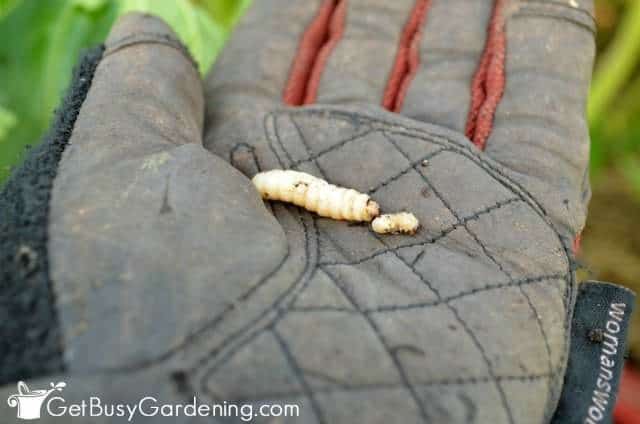
Life Cycle
There are four stages in the squash borer life cycle: eggs, larvae (borer), pupa, and adult (moth). The adults emerge in late spring or early summer, and the females will start laying eggs on nearby cucurbit plants shortly after.
They lay the eggs at the base of the plant, where they will hatch 1-2 weeks later. While they can lay a lot of eggs, the good news is that the moths are only active for about a month (usually June-July).
Shortly after the eggs hatch, the tiny squash borers will quickly burrow into the stem of the plant. As they feast they grow larger, reaching their full size of about 1″ long in 2-4 weeks.
Once they are full-sized, they will leave the vine and drop into the soil, where they’ll form a cocoon and pupate. They overwinter in the soil in 1″ long reddish-brown colored cocoons, and will hibernate until the following spring.
If you live in a cold climate like I do, there’s only one generation of squash borers per year. But in warmer climates, there can be two generations per year.
Related Post: How To Grow Summer Squash
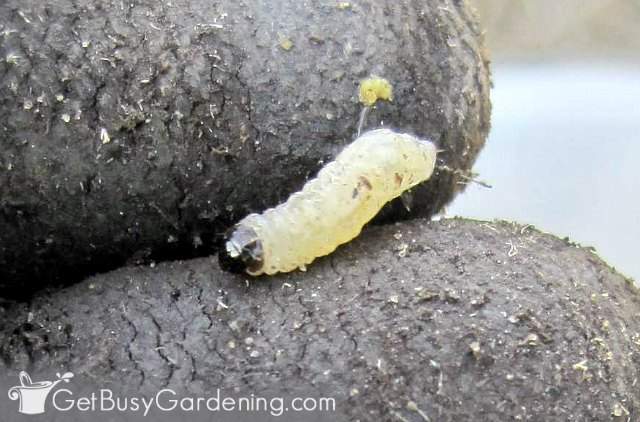
Where Do They Come From?
Since the adults can fly, squash borers could come from anywhere. They’re naturally attracted to cucurbits, since that’s their main host plant.
So, if the moths are present in your area of the world, and you’re growing any type of cucurbit plant, then it’s a sure bet they’ll find your garden.
What Do They Eat?
The main host plant for squash borer moths are vegetables in the Cucurbitaceae family. This includes all types of squash (both summer and winter), zucchini, pumpkins, and gourds, as well as melons, luffa, and cucumbers.
The borers do love squash plants the best though (hence their nickname). So, it’s much less common to find them feasting on cucumber and melon plants.
You’ll usually find squash borers eating the insides of the vines. But sometimes they will find their way into the fruits too, and destroy them from the inside out (Gross!).
The good news is that the larvae are the only stage in their life cycle where they eat plants. They are harmless in both their adult and pupa stages.
Related Post: How To Grow Winter Squash
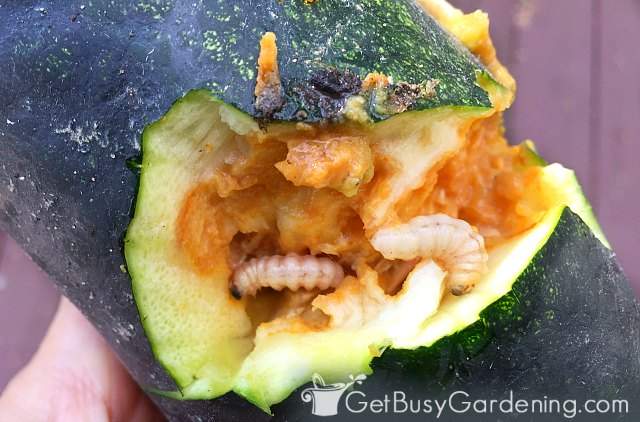
Damage To Plants
Since they eat the vines from the inside out, squash borer damage is difficult to spot unless you know what to look for.
If your squash plant has any of the symptoms below, then it’s time to take immediate action to get rid of the borers before they completely destroy the vine.
Here are the main signs to watch out for…
- Droopy leaves, or the entire plant suddenly wilts.
- Holes anywhere on the vine or stem.
- Mushy yellow sawdust coming out of the stem, vine, or fruits (this is their poop, also called frass).
- The vine is soft, split open, appears to be rotting, or is completely severed.
- Canker wounds or soft spots on the fruits.
- White worms inside your squash vines, stems, and/or the fruits.
Related Post: How To Grow Zucchini
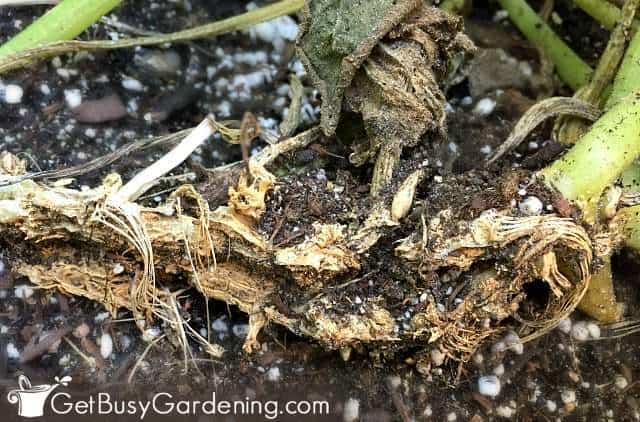
How To Get Rid Of Squash Vine Borers
Since they are inside the plant, pesticides (organic or otherwise) won’t work on them. But don’t worry, it’s pretty easy to get rid of squash borers organically by using a simple, non-toxic, and very effective method that I like to call… digging those nasty suckers out of the vine.
It takes a little bit of work, but it sounds harder than it is. And it really is the only way to get them out of the vine. Below I will walk you through how to do it step by step.
Supplies Needed
- Utility knife
- Bucket (optional)
- Liquid soap (optional)
- Water (optional)
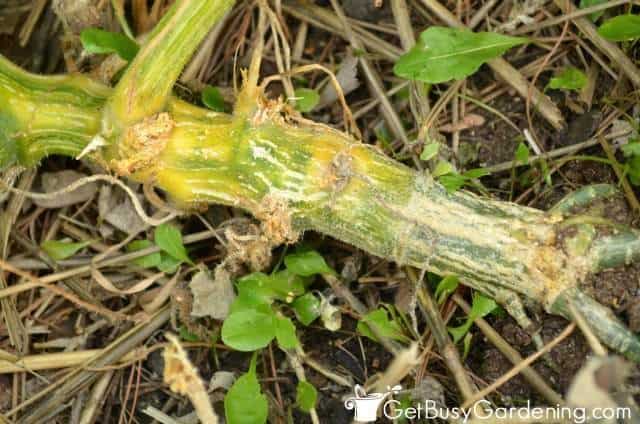
Step By Step Instructions
Step 1: Slice open the vine – Carefully slice open a small part of the vine just above the spot where you see the borer hole or sawdust mush.
Make a 1-2″ inch long cut the long way (i.e.: parallel to the vine) using a sharp utility knife. Take care not to sever the vine, you just need to open it up.
Step 2: Find the squash borer – Gently pry open the slit you made in the vine to look for the borer.
You may spot it right away, or you might need to make the cut a little larger so you can search around. It could be above or below the entry hole, but you’ll usually find them pretty close to the frass.
Step 3: Remove and kill it – Once you find a borer, pluck it out and kill it. You can simply squash it (pun intended!). Or, if that makes you too squeamish, then drop it into a bucket of soapy water.
Sometimes it’s easier to just squish it inside of the vine than it is to remove it. That’s fine, squash borer guts won’t harm your plant.
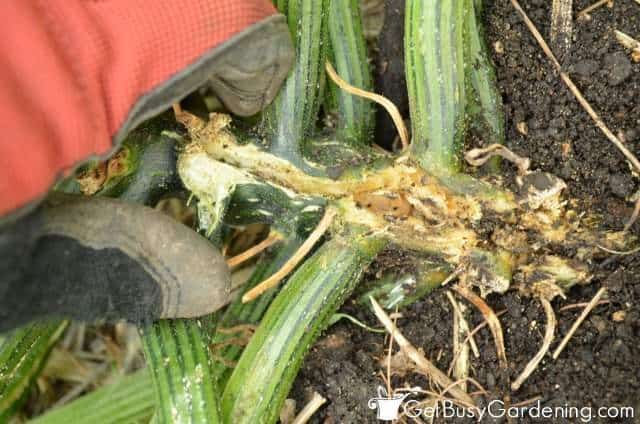
Step 4: Look for more squash borers – Continue inspecting the vine to look for signs of additional borers, and repeat steps 1-3 for each one that you find. There can be several of them inside of each vine.
Step 5: Bury the vine – Once you’re sure you’ve removed all of the borers, bury the injured section(s) of the vine with soil. Squash vines will form new roots under the soil, and the plant will become even stronger because of it.
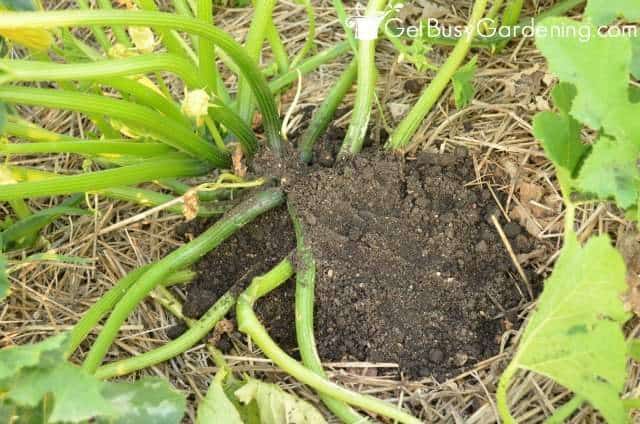
Additional Tips & Notes
Digging the borers out is the best way to get rid of them once they’re inside of the vine. And it’s so satisfying when you find them.
But sometimes you’ll see signs that there’s one inside the vine, and you can’t find anything after you cut it open.
Remember that the borers can be different sizes, and the smaller ones are much harder to spot than the big fat ones.
So don’t be discouraged. Maybe it was so small that you squished it without seeing it. Or maybe it was already fully mature and has left the vine. Just cover the injured part of the stem, and move on.
How To Prevent Squash Borers
There are lots of things you can do to prevent squash borers from infesting your plants in the first place. Use a combination of the techniques below to control their population, or even get rid of them all together.
Destroy The Eggs
Squash borer eggs are tiny, but they’re fairly easy to spot when you’re looking for them. The eggs are flat, oval shaped, and brown in color.
You’ll usually find them at the base of the stem of young plants, either at or near the soil line. But they can be anywhere on the vines of mature plants. There could be just one egg, or a few in a small cluster.
You can simply scrape the eggs off into a bucket of soapy water, or wash the vines with organic insecticidal soap to kill them. Be sure to inspect your plants regularly, and remove any new eggs before they hatch.
Related Post: Natural Garden Pest Control Remedies & Recipes
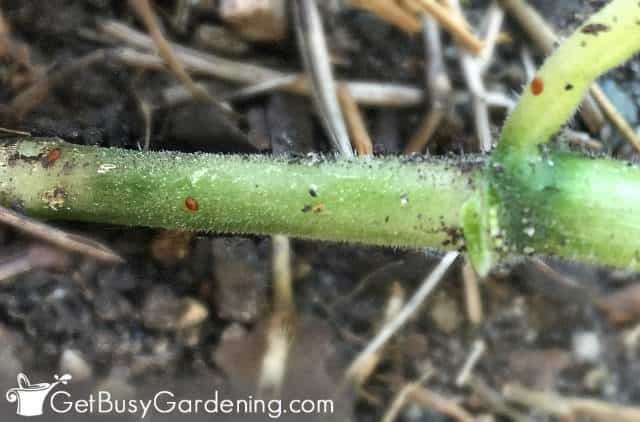
Try Sticky Traps
The adult squash borer moth is attracted to the color yellow. So, try placing sticky traps near your plants to trap them before they can lay their eggs.
These types of traps are completely non-toxic and safe to use in the veggie garden. They can also capture other pest insects too, which is a double bonus.
Use Aluminum Foil
Another great way to prevent squash borers is to wrap the stems of your plants in aluminum foil. This will confuse the moth, and prevent her from laying eggs. Here are the steps…
- Carefully dig down into the soil about 1/4″ inch around the base of the plant.
- Cut a small strip of aluminum foil, and wrap it around the entire stem of each plant.
- Push the soil back around the base of the stem, covering the bottom edge of the foil.
- Check the aluminum foil regularly, and re-wrap it if necessary.
Install Row Covers
Covering young squash plants helps to keep the borer moth from getting to the vines. You can buy row covers, or make your own out of inexpensive tulle fabric.
Keep in mind that this will also prevent pollinators from reaching your plants. So you should either hand pollinate your squash, or remove the row covers once the flowers start to open.
Destroy The Pupae In The Soil
As I already mentioned, squash borers overwinter in their pupa stage, and they hibernate in the soil. So, here are a few things you can do to get rid of them…
- Remove and destroy all of your cucurbit plants in the fall – especially any that have vine borer damage. Be sure to burn them or throw them into the trash, rather than putting them in your home compost bin. Otherwise, the pupa could just overwinter in there.
- Till or turn the soil in the fall and/or early spring to destroy the cocoons, or expose them to hungry predators.
Plant Trap Crops
Technically there is no such thing as a “squash borer-resistant plant”. Unfortunately, all types of cucurbits are susceptible to an infestation.
However, that being said, there are certain varieties that they prefer over others. They tend to really love zucchini (yellow and green) and hubbard squash the best.
Some gardeners use those varieties as trap crops to protect the less susceptible ones. A few of the borer’s least favorite varieties are butternut, tromboncino, and crookneck squash, as well as cucumbers and melons.
Related Post: How To Grow Cucumbers
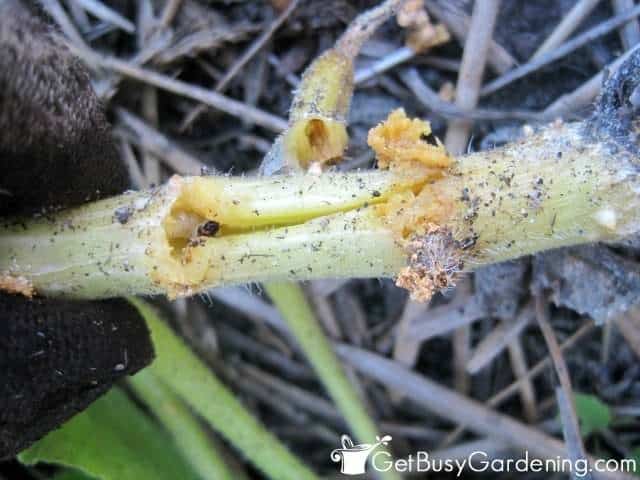
FAQs
While neem oil could kill the baby squash borers as they eat through the vine, it won’t work once they are inside the plant. If you want to try it, start applying it as soon as you plant your seedlings, and continue every few weeks until the moths are no longer active.
Diatomaceous earth can work to kill the adult moths and the larvae, but it won’t work once the squash borers are protected inside of the vine.
You can find squash vine borers inside of the stems, vines, or even the fruits of any type of cucurbit plant, including summer and winter squash, pumpkins, cucumbers, melons, and gourds.
Getting rid of squash vine borers can take some work, but it’s worth it to save your plants. Once you know the steps to take to control them, you can easily prevent them from ruining your crops.
If you’d like to learn how to make the most of your space and get as much homegrown food as possible, then my Vertical Vegetables book is perfect! It will teach you all you need to know, has tons of gorgeous photos, and includes 23 DIY projects you can build for your own garden. Order your copy today!
Learn more about my Vertical Vegetables book here.
Share your method for getting rid of squash vine borers in your garden, or your best prevention tips, in the comments below.
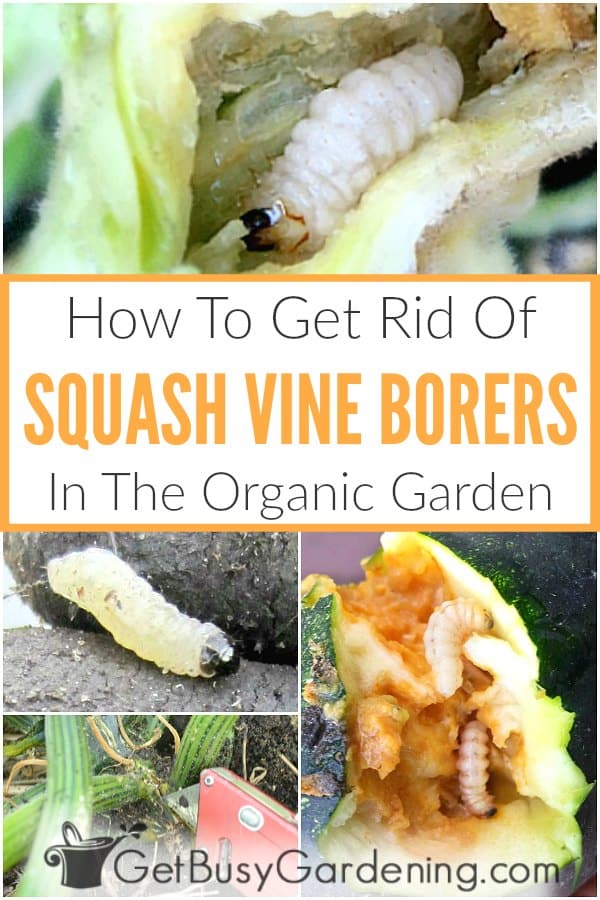
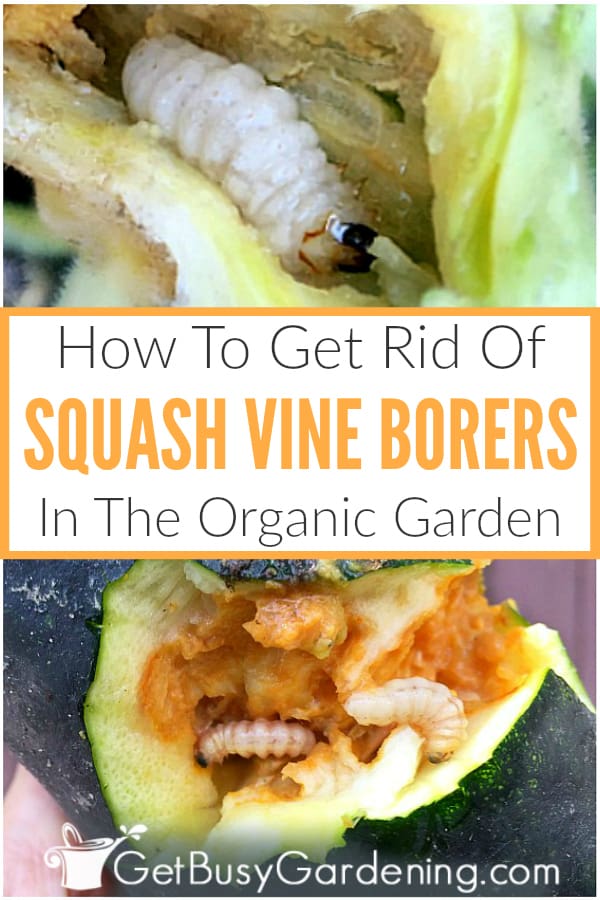
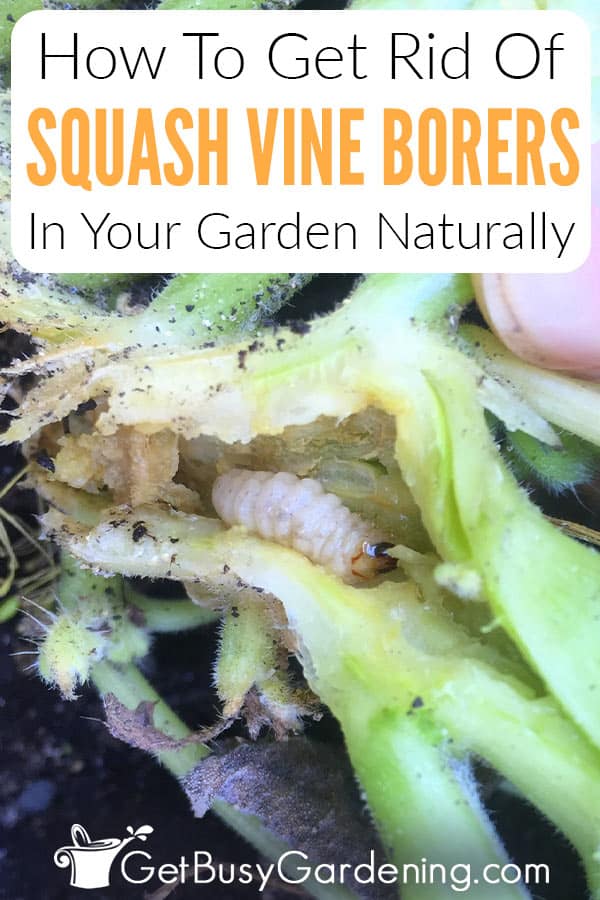

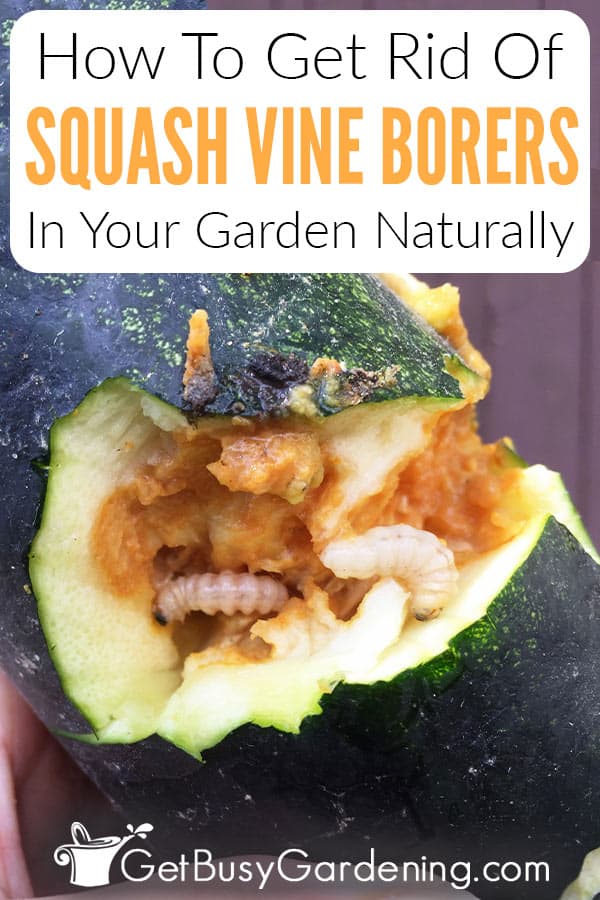
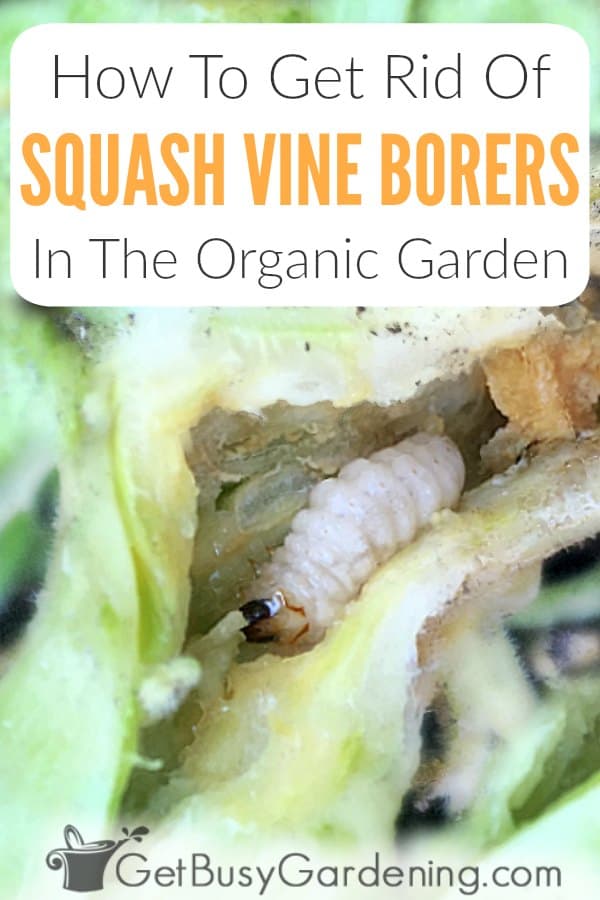
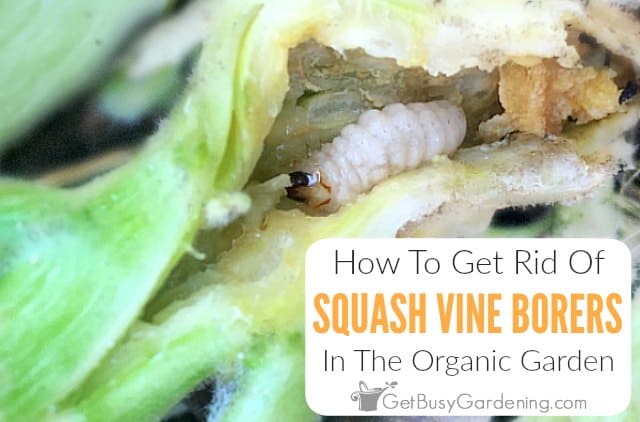

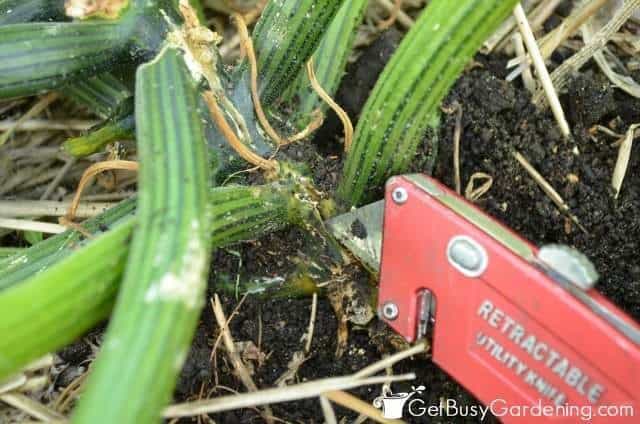


Marsha says
I do vertical growing for my butternut and spaghetti squash plants. It’s my first garden by myself so I’m taking it as a learning experience this year. I didn’t realize the squash bugs have different appearances so I’m battling the borers right now. I had lots of blooms on both plants so I’m really sad that I won’t have the crops i was planning on. Slicing the stems/vines aren’t helpful since I can’t bury them. Next year I’ll know what to do for prevention.